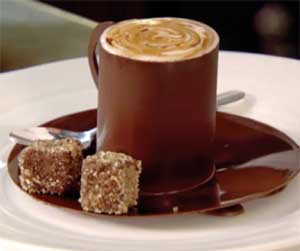Café Crème
From Raymond Blanc's Kitchen Secrets, http://www.raymondblanc.com/
A Le Manoir classic. A complex dish made up of simplified recipes. Break this down into 3 main recipes, and once you have mastered these techniques it will open the door to endless variations by only adding different flavours and combination of ingredients. Serves 4
 Special equipment
Special equipment
4 x 5cm x 5cm dia. dariole moulds
4 rectangular acetate 17½ cm x 6½ cm
4 x 5½ cm x 3 cm plastic rings
4 x 13cm dia. saucers
Small plate knife
Greaseproof paper
1 x rectangular frame 16cm x 23cm
Food probe
Sugar thermometer
Planning ahead:
The chocolate work needs to be prepared 24 hours in advance to allow the chocolate to set.
For the chocolate coffee cup
500g Dark chocolate 55%, such as Valrhona Guanaja
250g Dark chocolate 55%, ‘Valrhona’ chopped
4 Circles of sponge, 3cm dia.
Soaked in: 50ml Espresso coffee
For the coffee parfait & Kirsch sabayon
100g Caster sugar
70ml Water
80g 4 Egg yolks, medium, organic / free range
150g Whipping cream
10g Ristretto coffee (double strength espresso)
15g Kirsch
For the sugar cube ganache
300g Whipping cream
300g 55% Dark chocolate, ‘Valrhona’, chopped
75g/5tbsp Demerara sugar
For tempering the chocolate & preparing the chocolate coffee cups
Brush the base of the saucers with a little oil. (*1) Take a piece of cling film and place the saucer bottom-side down. Wrap the cling film around and twist to pull it tight over the saucer, ensure the surface is completely smooth. Repeat this for the remaining three saucers.
In a Bain Marie melt 2/3’rds of the chopped chocolate (500g), by heating to 55°C. Mix in the remaining 1/3rd of the chocolate (250g) and stir to cool rapidly, and reheat to 32 °C / 63°F (*2) dip the base of the saucer into the chocolate and shake off any excess. Using your thumb & forefinger encircle the plate removing chocolate from the border edge (to make a lip to allow easier release later) & then allow to set (not in the fridge or it may whiten, it needs 5 hours at least to set). Once set, carefully unwrap the cling film and peel away the cling film from the chocolate saucer. Reserve.
To make the coffee cup, using a small palette knife spread a thin layer 2-3mm of chocolate across the plastic acetate. Carefully lift a corner up using a pairing knife and hold the acetate by the edges. Bend the edges around to form a circle with the chocolate facing inwards and place into the plastic ring to hold the shape.
Ensure that there is a good seal all along the join by dipping your finger in the chocolate and covering the join with a thin layer.
Finally to make the handles fill a small piping bag with some tempered chocolate and pipe S-shapes with thickness of 3 mm onto the grease proof and allow to set.
When all items have set, assemble them together using some melted chocolate as the cement or gently melt the edges on the side of a hot stove before assembling.
Fold in the whipped cream; divide equally into two bowls, mixing the Kirsch into one bowl (and reserve in the fridge) and the coffee in the other. Then fill 4 dariole moulds up to the top with the coffee sabayon and place in the freezer. When frozen, de-mould by submerging the base of the moulds in boiling water and reserve the frozen parfaits in the freezer until needed
For preparing the ganache for the sugar cubes
In a small saucepan over a high heat boil the cream, allow to cool slightly then pour over the chocolate and whisk until smooth. Allow the mixture to cool (6 hours, this can be put in the fridge), then divide into 4 pieces and shape each individual piece into a square, roll in Demerara sugar to coat and reserve in the fridge until required.
For assembling the dessert
Carefully place the soaked sponge in the bottom of the chocolate coffee cups, followed by the frozen parfait, spoon the kirsch sabayon over the parfait, place two sugar cubes on the coffee cup saucer and serve to your guests.
Garnish with a swirl of coffee essence or caramel.
Chef’s Notes: ( *)
*1 This helps the cling film slip on the saucer
*2 Once melted, the cacao butter contained in the chocolate, can not regain its original form without help. It requires a crystallisation process which we call tempering.
Uncontrolled crystallization of cocoa butter typically results in crystals of varying size, some or all large enough to be clearly seen with the naked eye. This causes the surface of the chocolate to appear mottled and matte, and causes the chocolate to crumble rather than snap when broken. The uniform sheen and crisp bite of properly processed chocolate are the result of consistently small cocoa butter crystals produced by the tempering process. By adding the chopped chocolate to the hot melted chocolate you will cool the chocolate quickly. As the chocolate cools, crystals within the cocoa butter crystallize leaving the chocolate not only at the right consistency to work at but also tempering it gives it its shiny appearance and a nice smooth, cracking texture. Too much heat at this stage will spoil the tempering and you'll have to start again!
Variations:
Sabayon
Serve the sabayon on its own, poured over some seasonal berries and dusted with icing sugar.
Parfait
Make a larger amount of the coffee parfait and freeze it in a terrine mould. Slice and serve with toasted nuts and caramel sauce.
Ganache
The ganache cubes would be a lovely petit four after a dinner party.

